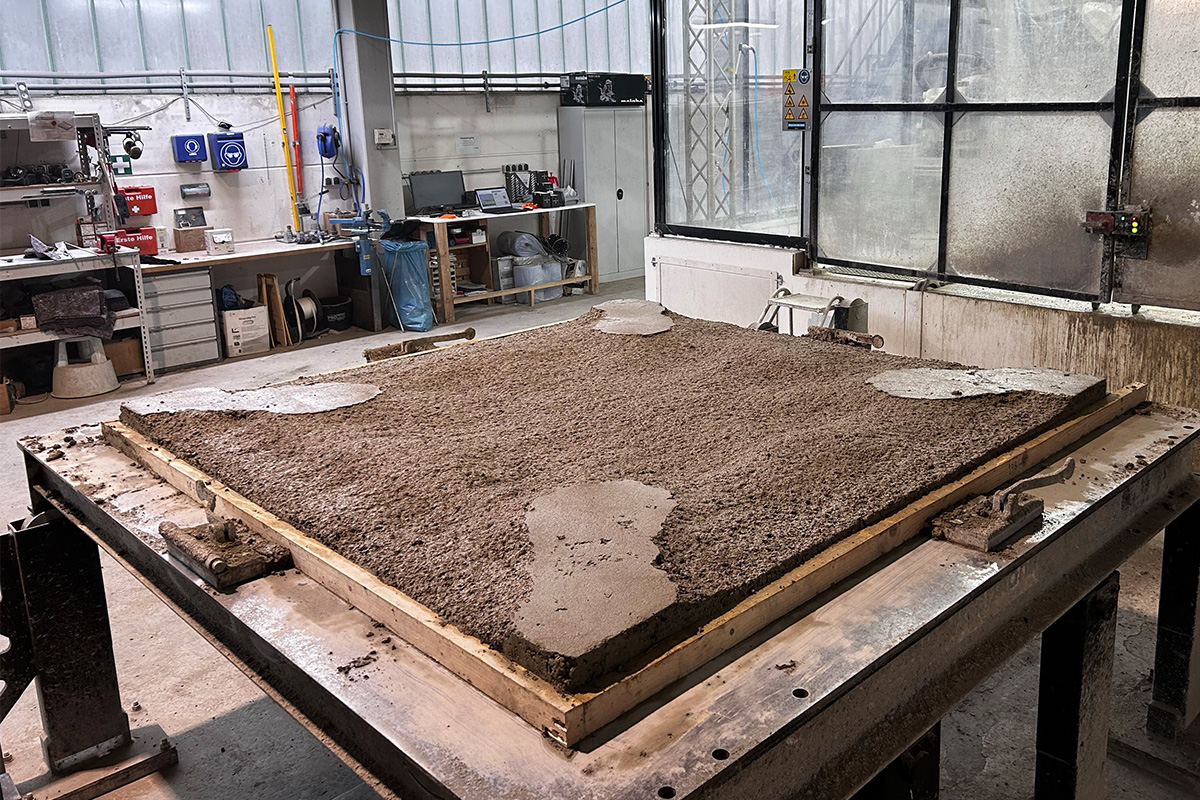#Concrete Aeditor #Technologies & Trends
Form efficiency: the savings potential of additive manufacturing technologies.
The technology to produce form- and cost-efficient reinforced concrete components is already here. Drawing on innovative processes such as the Concrete Aeditor, precast concrete plants can achieve significant savings.

According to a recent PwC study (1), digitalization in the construction industry has stalled, despite two-thirds of respondents still seeing significant room for improvement. Only in the areas of administration and project planning has the use of digital tools and technologies been established on a significant scale. While the technical capabilities for simulation and design exist, wider implementation often fails due to the significant digitalization gap still present in the path to production. This is disappointing and unnecessary given the scale of the challenges ahead and the technological solutions available. The potential to be unlocked is enormous.
Superior form efficiency through intelligent part design
Modern, iterative computational methods enable the creation of highly accurate designs for force-optimized components. The necessary tools, computing power for efficient use, and algorithmic expertise are widely available today. In addition, rapid advances in AI are further enhancing these capabilities. Prefabricated concrete components can now be designed and optimized for form efficiency, such as material savings, weight reduction, or volume optimization.
However, the manufacturing of such force-optimized components using conventional formwork methods is usually not economically viable, so that all to often, this approach is abandoned altogether. Instead, halfway solutions such as simple geometric shape adjustments are employed to achieve some material savings or weight reduction. Ultimately, the relatively simple formwork geometries still dictate the shape of the part, resulting in excessive material being introduced even where neither compression nor tension forces are at play.
Additive manufacturing processes enable the cost-effective production of form-optimized components
Modern additive manufacturing processes already enable the cost-effective production of form-optimized concrete components, and with innovative technologies, such as our Robotic Shotcrete Printing (RSP), even the reinforcements are not a problem. Let’s take the example of a simple ceiling slab to illustrate the material savings achievable with the Concrete Aeditor and the resulting benefits.
Ceiling slab: 60% material savings through form efficiency
We compare a conventionally produced slab with a form-optimized slab produced with the Concrete Aeditor. This is a generic comparison of course, as structural framework and loads must be specifically calculated according to requirements and application.
Reduced material consumption
Compared to a conventionally produced slab, up to 60% of material can be saved by optimizing the component shape and producing it with the Concrete Aeditor.
In the context of sustainability, especially regarding CO2 emissions, this reduction in concrete consumption represents a significant lever that must be utilized.
Production effort
Thanks to a fully digital process chain, optimized component geometries can be adopted directly from the design stage. The time, cost, and material-intensive formwork production is either eliminated entirely or significantly reduced. Furthermore, form complexity poses no challenge for the RSP process.
Simplified logistics
Less material, especially in concrete, means less weight and often less volume. This not only benefits production and interim storage, but also provides significant cost and emission savings during transport.
Improved occupational safety
The reduced weight of precast concrete reduces the risk of injury and accidents in the factory, during transport and during installation on site.
Reduced strain on construction machinery and equipment
Lighter concrete parts may require less robust lifting and transport equipment, reducing costs and potentially extending the lifespan of machinery.
More flexible design options
The reduced weight of individual components positively impacts the load-bearing capacity and statics of the entire structure, allowing for more creative, sophisticated, or otherwise optimized structures.
The technology is ready, are you?
Technologies for the cost-effective production of form-efficient component geometries are mature and available. To realize the full potential, manufacturing processes should be considered as early as the design phase. Even for structural components, significant savings can be achieved with a holistic, mature, and industrially available manufacturing process such as the Concrete Aeditor. Depending on the application, individual components can be designed with different optimization goals: whether purely material-optimized for maximum concrete and cement savings, volume-optimized for transport, or visually optimized for specific aesthetic requirements. Our innovative Robotic Shotcrete Printing opens up many possibilities that would be unthinkable with traditional manufacturing methods.
Give yourself a head start and contact us now to learn more about RSP and Concrete Aeditor to drive digitalization forward in your precast concrete production site – for increased efficiency, safety, and sustainability.
+++ References (in German):
(1) PwC Study 2024: Die Bauindustrie in Krisenzeiten: Fortschritte bei ESG, Stillstand bei der Digitalisierung

